Investigation of Outdoor Thermal Comfort for Campus Pedestrian Walkways in Thailand
Abstract
1. Introduction
2. Literature Review
3. Materials and Methods
3.1. Defining the Study Area
- Walkway with sparse trees on one side: Chiang Rai 2 road;
- Walkway with sparse trees: Main entrance road;
- Walkway with dense trees: Chiang San 201 road;
- Cantilever-covered walkway with sparse trees: Khe Larng 4 (Zone A) road;
- Open-sided covered walkway with sparse trees: Khe Larng 4 (Zone B) road.
- Walkway No. 1 (walkway with sparse trees on one side) consists of a pedestrian walkway and bike lane along the road. The walkway is surrounded by tall and sparse trees on one side of the walkway (see Figure 4).
- Walkway No. 2 (walkway with sparse trees) consists of a pedestrian walkway surrounded by tall and sparse trees on both sides of the walkway (see Figure 5).
- Walkway No. 3 (walkway with dense trees) consists of a pedestrian walkway surrounded by a large number of trees along the walkway (see Figure 6).
- Walkway No. 4 (open-sided covered walkway with sparse trees) consists of a pedestrian walkway with open-sided covers surrounded by tall and sparse trees on one side of the walkway (see Figure 7).
- Walkway No. 5 (cantilever-covered walkway with sparse trees) consists of a pedestrian walkway with cantilevered covers surrounded by tall and sparse trees on both sides of the walkway (see Figure 8).
3.2. Collecting Data
3.2.1. Microclimate Monitoring
3.2.2. Questionnaire Survey
3.3. Analysis of Physiological Equivalent Temperature
3.4. Determination of Thermal Acceptability Range
4. Results and Discussion
4.1. Assessment of Physiological Equivalent Temperature and Thermal Sensation Vote
- Walkways with sparse trees on one side (No. 1) vs. both sides (No. 2). The walkway with trees on one side (No. 1) produces a higher air temperature than that with trees on both sides (No. 2). The PET of walkway No. 1 is higher than that of walkway No. 2 and slightly higher than the neutral PET. Walkway No. 1 has a higher TSV than that of No. 2, and it has fewer votes at the neutral sensation level (TSV = 0) than that of No. 2. It is clear that pedestrians on the walkway with sparse trees on one side (No. 1) feel less comfortable than those with trees on both sides (No. 2).
- Walkways with sparse trees vs. dense trees. The results show that the walkways surrounded by either sparse trees (No. 2) or dense trees (No. 3) have the same air temperature and wind speed. The PET of walkway No. 3 is slightly lower than that of walkway No. 2. This may be because walkway No. 3 has dense trees, which cause less light, and walkway No. 2 has tall and open trees, which allow light to reach the walkway. Pedestrians on walkway No. 2 feel hotter than those on No. 3; the thermal sensation vote is higher. Pedestrians on the walkway with sparse trees (No. 2) feel less comfortable than those with dense trees (No. 3).
- Walkways with dense trees vs. covered walkways with sparse trees. The air temperatures of both walkway types are similar, while the wind speed of the covered walkway (No. 4) is slightly higher than that of the walkways with dense trees (No. 3). Walkway No. 3 allows the sunlight to reach the walkway, while walkway No. 4 protects the walkway from direct sunlight. The PET on walkway No. 4 is lower than that on No. 3. The thermal sensation votes of both walkway types are about the same, but walkway No. 4 has a wider thermal acceptability range (from TSV+3 to TSV−2). It can be concluded that pedestrians on the covered walkway (No. 4) feel slightly more comfortable than those on the walkway with dense trees due to the lower PET.
- Covered walkways vs. cantilever-covered walkways. The thermal comfort conditions of both walkway types are quite different. Walkway No. 4 (one-sided covered walkway) has a higher air temperature than walkway No. 5 (cantilever-covered walkway). Moreover, the wind speed of walkway No. 5 is significantly higher than that of walkway No. 4. This may be because walkway No. 5 has tall and open trees, so the wind is rapidly circulated. The PET of walkway No. 5 is thus significantly lower than that of walkway No. 4 (lower by 1.6 °C PET). The thermal sensation vote ranges of both walkway types are similar, but the percentage of thermal acceptability of walkway No. 5 is more than that of walkway No. 4. It can be concluded that pedestrians on cantilever-covered walkways feel more comfortable than those on covered walkways.
4.2. Analysis of Thermal Acceptability Range
4.3. Comparison of Other Outdoor Thermal Comfort Studies
5. Conclusions and Recommendations
Author Contributions
Funding
Institutional Review Board Statement
Informed Consent Statement
Data Availability Statement
Acknowledgments
Conflicts of Interest
References
- Emmanuel, R. Urban Climate Challenges in the Topics: Rethinking Planning and Design Opportunities; Imperial College Press: London, UK, 2016. [Google Scholar]
- Krellenberg, K.; Bergsträßer, H.; Bykova, D.; Kress, N.; Tyndall, K. Urban sustainability strategies guided by the SDGs—A tale of four cities. Sustainability 2019, 11, 1116. [Google Scholar] [CrossRef]
- Pojani, D.; Stead, D. Sustainable urban transport in the developing world: Beyond megacities. Sustainability 2015, 7, 7784–7805. [Google Scholar] [CrossRef]
- Shafray, E.; Kim, S. A study of walkable spaces with natural elements for urban regeneration: A focus on cases in Seoul, South Korea. Sustainability 2017, 9, 587. [Google Scholar] [CrossRef]
- Biggar, M. Non-motorized transport: Walking and cycling. In Sustainable Cities and Communities. Encyclopedia of the UN Sustainable Development Goals; Leal Fihro, W., Azul, A., Brandli, L., Özuyar, P., Wall, T., Eds.; Springer: Cham, Switzerland, 2020; pp. 1–10. [Google Scholar]
- Turrell, G.; Hewitt, B.; Haynes, M.; Nathan, A.; Giles-Corti, B. Change in walking for transport: A longitudinal study of the influence of neighbourhood disadvantage and individual-level socioeconomic position in mid-aged adults. Int. J. Behav. Nutr. Phys. Act. 2014, 11, 151. [Google Scholar] [CrossRef]
- Kaplan, D.H. Transportation sustainability on a university campus. Int. J. Sustain. High. 2015, 16, 173–186. [Google Scholar] [CrossRef]
- Lin, T.-P.; Matzarakis, A.; Hwang, R.-L. Shading effect on long-term outdoor thermal comfort. Build. Environ. 2010, 45, 213–221. [Google Scholar] [CrossRef]
- Zhao, L.; Zhou, X.; Li, L.; He, S.; Chen, R. Study on outdoor thermal comfort on a campus in a subtropical urban area in summer. Sustain. Cities Soc. 2016, 22, 164–170. [Google Scholar] [CrossRef]
- Huang, Z.; Cheng, B.; Gou, Z.; Zhang, F. Outdoor thermal comfort and adaptive behaviors in a university campus in China’s hot summer-cold winter climate region. Build. Environ. 2019, 165, 106414. [Google Scholar] [CrossRef]
- Aghamohammadi, N.; Fong, C.S.; Mohd Idrus, M.H.; Ramakreshnan, L.; Haque, U. Outdoor thermal comfort and somatic symptoms among students in a tropical city. Sustain. Cities Soc. 2021, 72, 103015. [Google Scholar] [CrossRef]
- Blazejczyk, K. New climatological-and-physiological model of the human heat balance outdoor and its applications in bioclimatological studies in different scales. In Bioclimatic Research on the Human Heat Balance; Blazejczyk, K., Krawczyk, B., Eds.; ZESZYTY: Warsaw, Poland, 1994; Volume 28, pp. 27–58. [Google Scholar]
- De Freitas, C.R.; Grigorieva, E.A. A comprehensive catalogue and classification of human thermal climate indices. Int. J. Biometeorol. 2015, 59, 109–120. [Google Scholar] [CrossRef]
- Matzarakis, A.; Mayer, H.; Iziomon, M. Applications of a universal thermal index: Physiological equivalent temperature. Int. J. Biometeorol. 1999, 43, 76–84. [Google Scholar] [CrossRef]
- Höppe, P. The physiological equivalent temperature—A universal index for the biometeorological assessment of the thermal environment. Int. J. Biometeorol. 1999, 43, 71–75. [Google Scholar] [CrossRef] [PubMed]
- Lai, D.; Guo, D.; Hou, Y.; Lin, C.; Chen, Q. Studies of outdoor thermal comfort in northern China. Build. Environ. 2014, 77, 110–118. [Google Scholar] [CrossRef]
- Niu, J.; Liu, J.; Lee, T.-C.; Lin, Z.; Mak, C.M.; Tse, K.-T.; Tang, B.-S.; Kwok, K. A new method to assess spatial variations of outdoor thermal comfort: Onsite monitoring results and implications for precinct planning. Build. Environ. 2015, 91, 263–270. [Google Scholar] [CrossRef]
- Li, J.; Liu, N. The perception, optimization strategies and prospects of outdoor thermal comfort in China: A review. Build. Environ. 2020, 170, 106614. [Google Scholar] [CrossRef]
- Cheng, V.; Ng, E.; Chan, C.; Givoni, B. Outdoor thermal comfort study in a sub-tropical climate: A longitudinal study based in Hong Kong. Int. J. Biometerol. 2012, 56, 43–56. [Google Scholar] [CrossRef] [PubMed]
- Fanger, P.O. Thermal Comfort: Analysis and Applications in Environmental Engineering; McGraw-Hill Book Company: New York, NY, USA, 1972. [Google Scholar]
- Auliciems, A.; Szokolay, S.V. Thermal Comfort, 2nd ed.; University of Queensland: Brisbane, Australia, 2007; pp. 15–43. [Google Scholar]
- ASHARE Standard 55-2017; Thermal Environmental Conditions for Human Occupancy. American Society of Heating. Refrigerating and Air-Conditioning Engineers: Atlanta, GA, USA, 2017.
- Li, K.; Zhang, Y.; Zhao, L. Outdoor thermal comfort and activities in the urban residential community in a humid subtropical area of China. Energy Build. 2016, 133, 498–511. [Google Scholar] [CrossRef]
- Lin, T.-P.; Matzarakis, A. Tourism climate and thermal comfort in Sun Moon Lake, Taiwan. Int. J. Biometeorol. 2008, 52, 281–290. [Google Scholar] [CrossRef]
- Coccolo, S.; Kämpf, J.; Scartezzini, J.-L.; Pearlmutter, D. Outdoor human comfort and thermal stress: A comprehensive review on models and standards. Urban Clim. 2016, 18, 33–57. [Google Scholar] [CrossRef]
- Abraham, A.; Sommerhalder, K.; Adel, T. Landscape and well-being: A scoping study on the health-promoting impact of outdoor environments. Int. J. Public Health 2010, 55, 59–69. [Google Scholar] [CrossRef] [PubMed]
- Lin, T.-P. Thermal perception, adaptation and attendance in a public square in hot and humid regions. Build. Environ. 2009, 44, 2017–2026. [Google Scholar] [CrossRef]
- Nikolopoulou, M.; Baker, N.; Steemers, K. Thermal comfort in outdoor urban spaces: Understanding the human parameter. Sol. Energy 2011, 70, 227–235. [Google Scholar] [CrossRef]
- Mayer, H.; Höppe, P. Thermal comfort of man in different urban environments. Theor. Appl. Climatol. 1987, 38, 43–49. [Google Scholar] [CrossRef]
- Matzarakis, A.; Mayer, H. Another kind of environmental stress: Thermal stress. WHO collaborating centre for air quality management and air pollution control. Newsletters 1996, 18, 7–10. [Google Scholar]
- Potchter, O.; Cohen, P.; Lin, T.-P.; Matzarakis, A. Outdoor human thermal perception in various climates: A comprehensive review of approaches, methods, and quantification. Sci. Total Environ. 2018, 631–632, 390–406. [Google Scholar] [CrossRef] [PubMed]
- Cohen, P.; Potchter, O.; Matzarakis, A. Human thermal perception of coastal mediterranean outdoor urban environments. Appl. Geogr. 2013, 37, 1–10. [Google Scholar] [CrossRef]
- Zölch, T.; Rahman, M.A.; Pfleiderer, E.; Wagner, G.; Pauleit, S. Designing public squares with green infrastructure to optimize human thermal comfort. Build. Environ. 2019, 149, 640–654. [Google Scholar] [CrossRef]
- Matzarakis, A.; Amelung, B. Physiological Equivalent Temperature as indicator for impacts of climate change on thermal comfort of humans. Adv. Glob. Change Res. 2008, 30, 161–172. [Google Scholar]
- Zhang, L.; Wei, D.; Hou, Y.; Du, J.; Liu, Z.; Zhang, G.; Shi, L. Outdoor thermal comfort of urban park—A case study. Sustainability 2020, 12, 1961. [Google Scholar] [CrossRef]
- Zaninovic, K.; Matzarakis, A. Variation and trends of thermal comfort at the Adriatic coast. In Advances in Tourism Climatology; Matzarakis, A., de Freitas, C.R., Scott, D., Eds.; Meteorologisches Institut der Universität Freiburg: Freiburg, Germany, 2004; pp. 74–81. [Google Scholar]
- Kántor, N.; Égerházi, L.; Unger, J. Subjective estimation of thermal environment in recreational urban spaces. Part 1: Investigations in Szeged, Hungary. Int. J. Biometeorol. 2012, 56, 1075–1088. [Google Scholar] [CrossRef]
- Tsitoura, M.; Tsoutsos, T.; Daras, T. Evaluation of comfort conditions in urban open spaces. Application in the island of Crete. Energy Convers. Manag. 2014, 86, 250–258. [Google Scholar] [CrossRef]
- Yang, B.; Olofsson, T.; Nair, G.; Kabanshi, A. Outdoor thermal comfort under subarctic climate of north Sweden—A pilot study in Umeå. Sustain. Cities Soc. 2017, 28, 387–397. [Google Scholar] [CrossRef]
- Hwang, R.L.; Lin, T.-P. Thermal comfort requirements for occupants of semi-outdoor and outdoor environments in hot-humid regions. Archit. Sci. Rev. 2007, 50, 357–364. [Google Scholar] [CrossRef]
- Li, K.; Xia, T.; Li, W. Evaluation of subjective feeling of outdoor thermal comfort in residential areas: A case study of Wuhan. Buildings 2021, 11, 389. [Google Scholar] [CrossRef]
- Wang, Y.; Ni, Z.; Peng, Y.; Xia, B. Local variation of outdoor thermal comfort in different urban green spaces in Guangzhou, a subtropical city in South China. Urban For. Urban Green. 2018, 32, 99–112. [Google Scholar] [CrossRef]
- Cheung, P.K.; Jim, C.Y. Subjective outdoor thermal comfort and urban green space usage in humid-subtropical Hong Kong. Energy Build. 2018, 173, 150–162. [Google Scholar] [CrossRef]
- Makaremi, N.; Salleh, E.; Jaafar, M.Z.; GhaffarianHoseini, A. Thermal comfort conditions of shaded outdoor spaces in hot and humid climate of Malaysia. Build. Environ. 2012, 48, 7–14. [Google Scholar] [CrossRef]
- Esmaili, R.; Montazeri, M. The determine of the Mashad bioclimatic condition based on hourly data. Geogr. Environ. Plan. J. 2013, 49, 45–59. [Google Scholar]
- Ali, S.B.; Patnaik, S. Thermal comfort in urban open spaces: Objective assessment and subjective perception study in tropical city of Bhopal, India. Urban Clim. 2018, 24, 954–967. [Google Scholar] [CrossRef]
- Acero, J.A.; Koh, E.J.K.; Pignatta, G.; Norford, L.K. Clustering weather types for urban outdoor thermal comfort evaluation in a tropical area. Theor. Appl. Climatol. 2020, 139, 659–675. [Google Scholar] [CrossRef]
- Yang, W.; Wong, N.H.; Jusuf, S.K. Thermal comfort in outdoor urban spaces in Singapore. Build. Environ. 2013, 59, 426–435. [Google Scholar] [CrossRef]
- Thorsson, S.; Honjo, T.; Lindberg, F.; Eliasson, I.; Lim, E.M. Thermal comfort and outdoor activity in Japanese urban public places. Environ. Behav. 2007, 39, 660–684. [Google Scholar] [CrossRef]
- Shooshtarian, S.; Lam, C.K.C.; Kenawy, I. Outdoor thermal comfort assessment: A review on thermal comfort research in Australia. Build. Environ. 2020, 177, 106917. [Google Scholar] [CrossRef]
- Zhao, Q.; Sailor, D.J.; Wentz, E.A. Impact of tree locations and arrangements on outdoor microclimates and human thermal comfort in an urban residential environment. Urban For. Urban Green 2018, 32, 81–91. [Google Scholar] [CrossRef]
- Deng, Y.; Gan, D.; Tang, N.; Cai, Z.; Li, X.; Chen, S.; Li, X. Research on outdoor thermal comfort and activities in residential areas in subtropical China. Atmosphere 2022, 13, 1357. [Google Scholar] [CrossRef]
- Mayer, H.; Holst, J.; Dostal, P.; Imbery, F.; Schindler, D. Human thermal comfort in summer within an urban street canyon in Central Europe. Meteoral. Z. 2008, 17, 241–250. [Google Scholar] [CrossRef]
- Boussaidi, K.; Djaghrouri, D.; Benabbas, M.; Altan, H. Assessment of outdoor thermal comfort in urban public space, during the hottest period in Annaba City, Algeria. Sustainability 2023, 15, 11763. [Google Scholar] [CrossRef]
- Chen, L.; Mak, C.M.; Hang, J.; Dai, Y. Influence of elevated walkways on outdoor thermal comfort in hot-humid climates based on on-site measurement and CFD modeling. Sustain. Cities Soc. 2023, 100, 105048. [Google Scholar] [CrossRef]
- Fang, Z.; Lin, Z.; Mak, C.M.; Niu, J.; Tae, K.-T. Investigation into sensitivities of factors in outdoor thermal comfort indices. Build Environ. 2018, 128, 129–142. [Google Scholar] [CrossRef]
- Cochran, W.G. Sample Techniques, 3rd ed.; John Wiley & Sons: New York, NY, USA, 1977; pp. 72–88. [Google Scholar]
- Nasrollahi, N.; Ghosouri, A.; Khodakarami, J.; Taleghani, M. Heat-Mitigation Strategies to Improve Pedestrian Thermal Comfort in Urban Environments: A Review. Sustainability 2020, 12, 10000. [Google Scholar] [CrossRef]

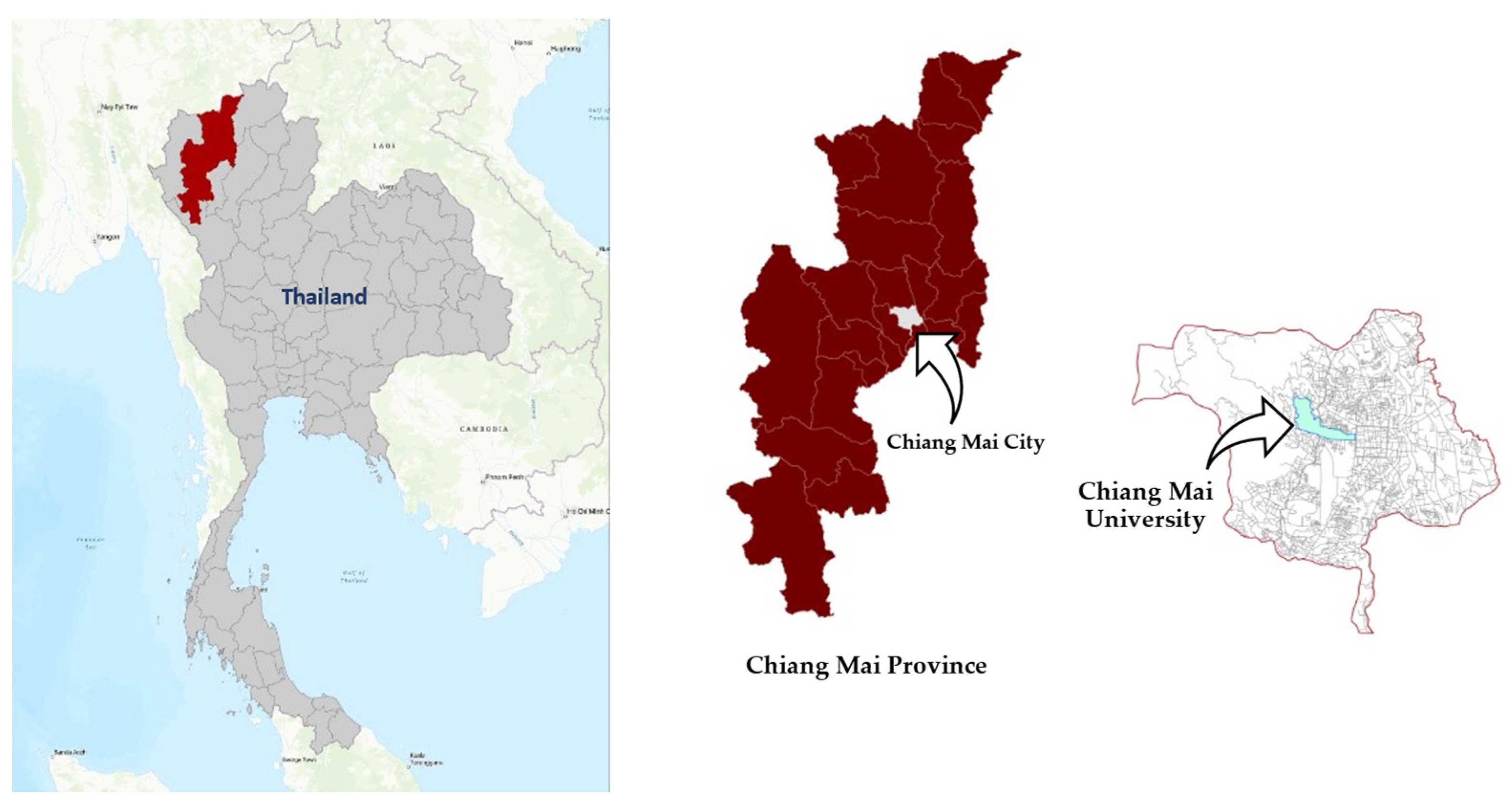
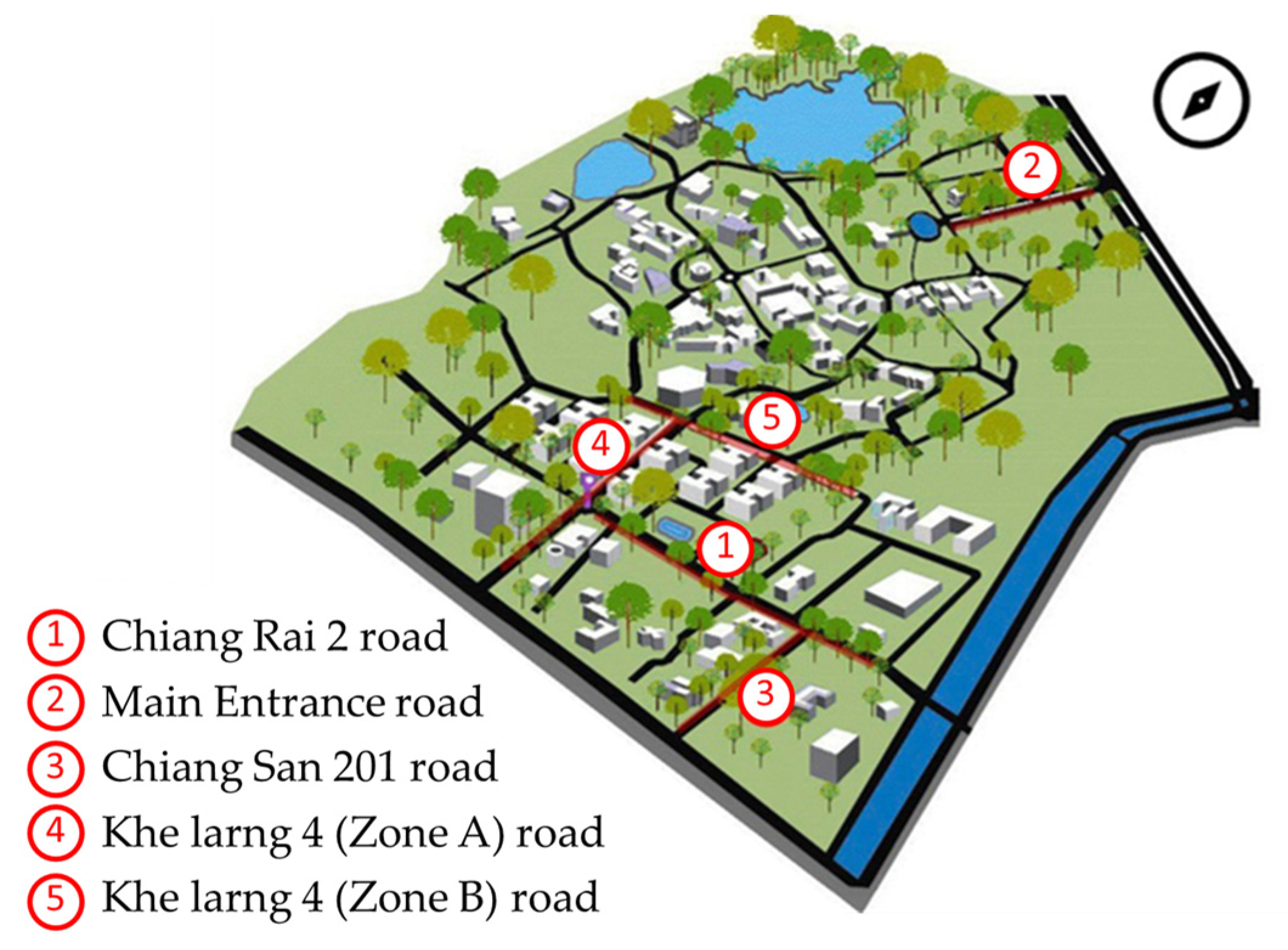






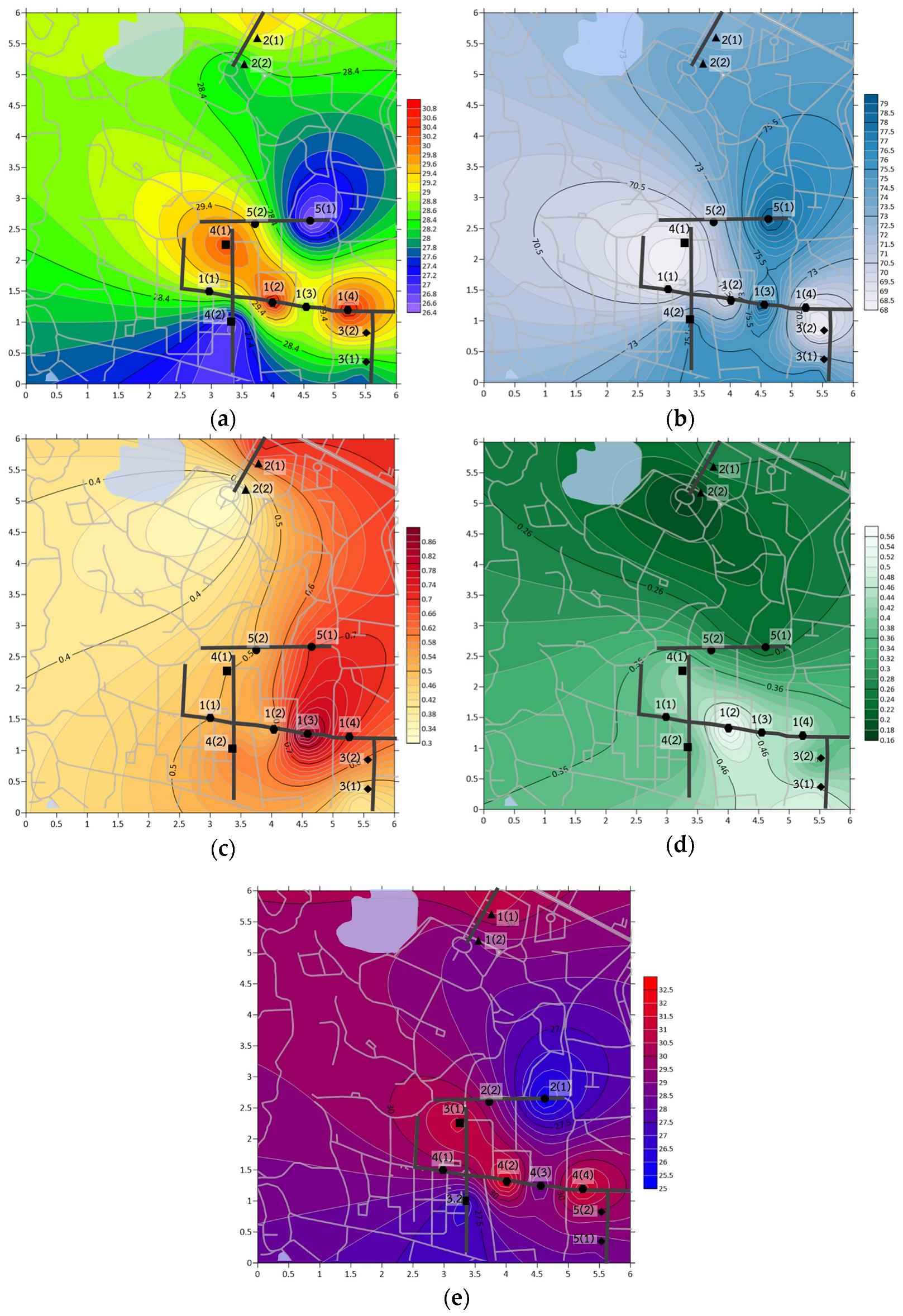


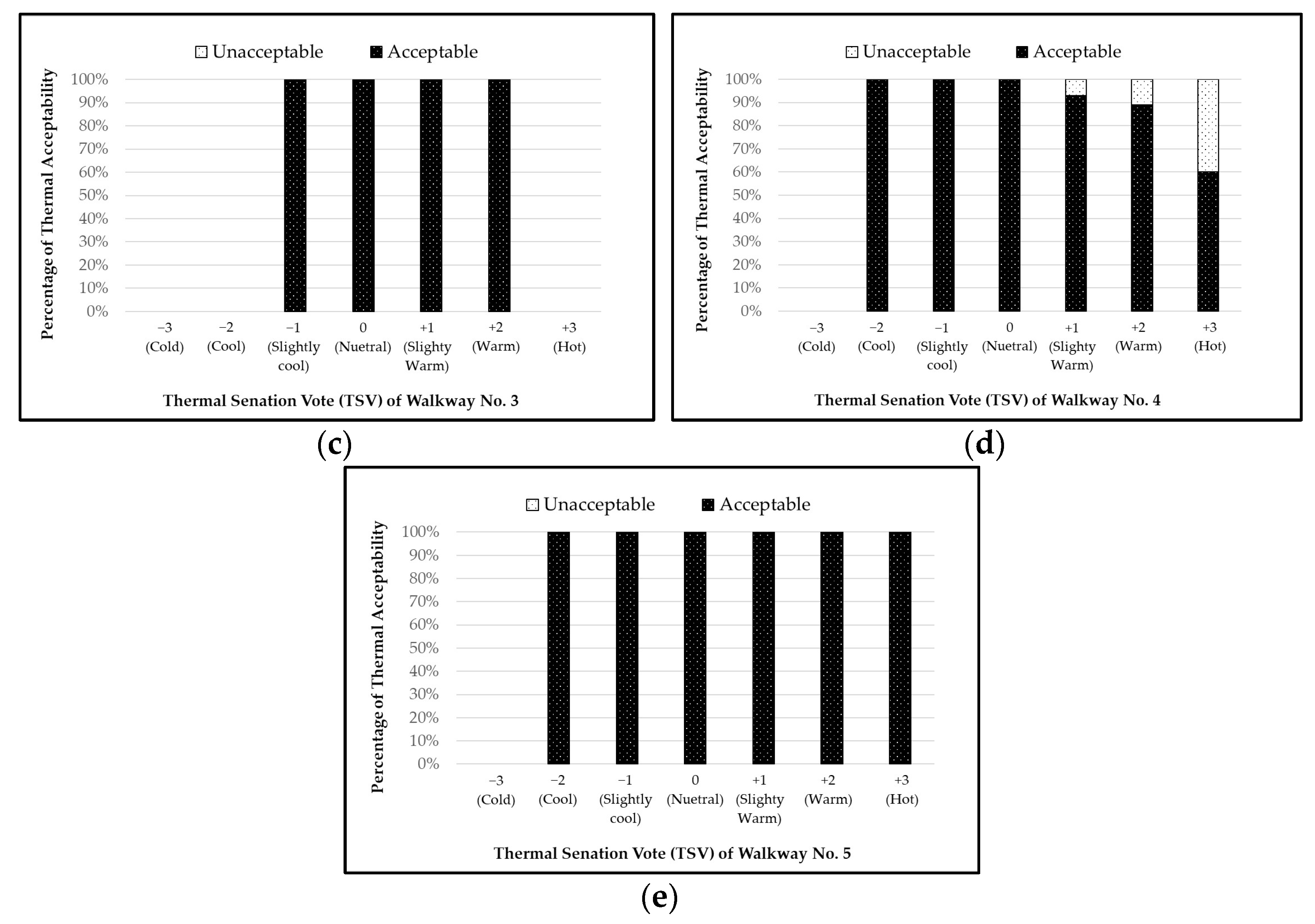
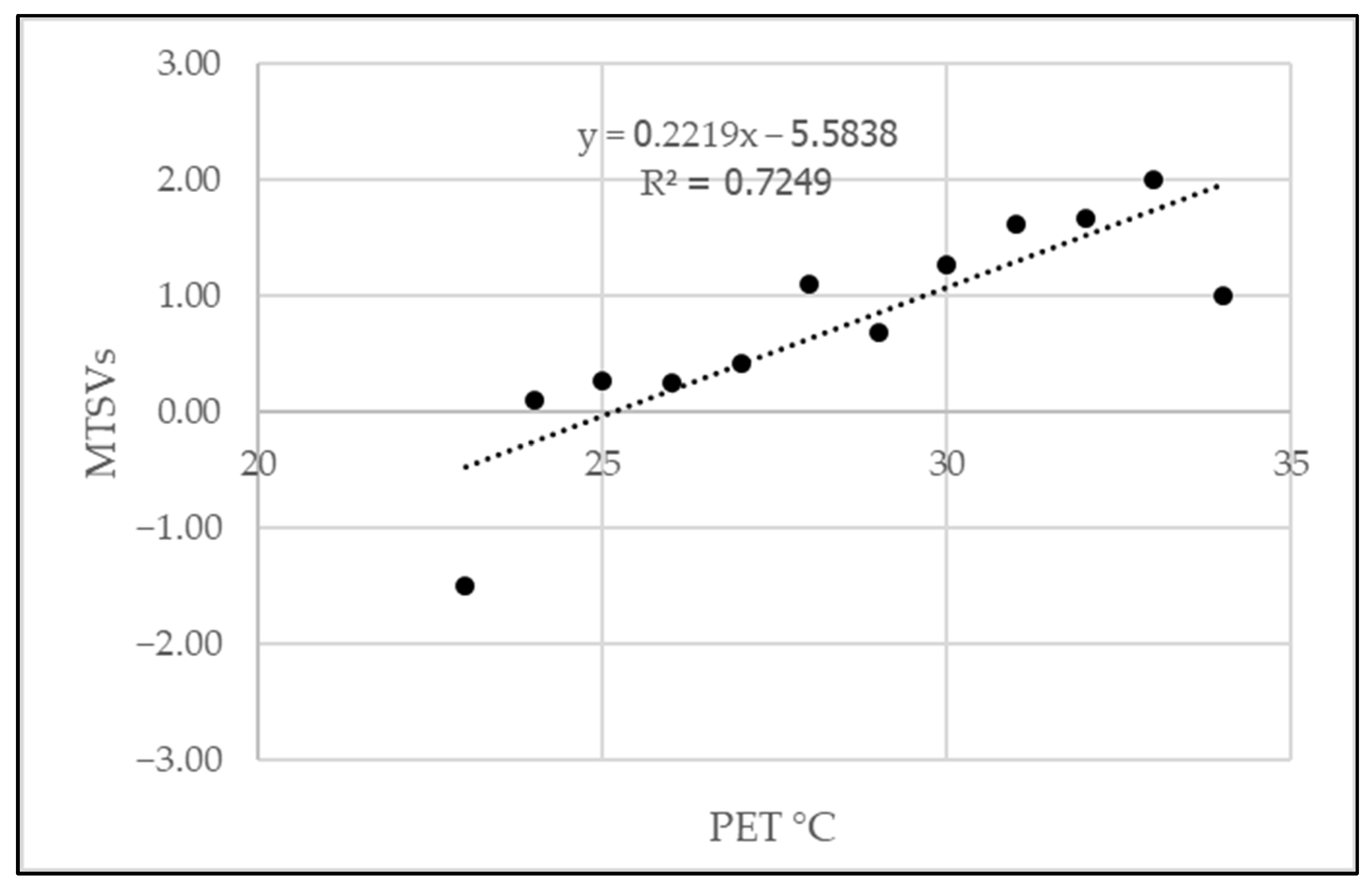
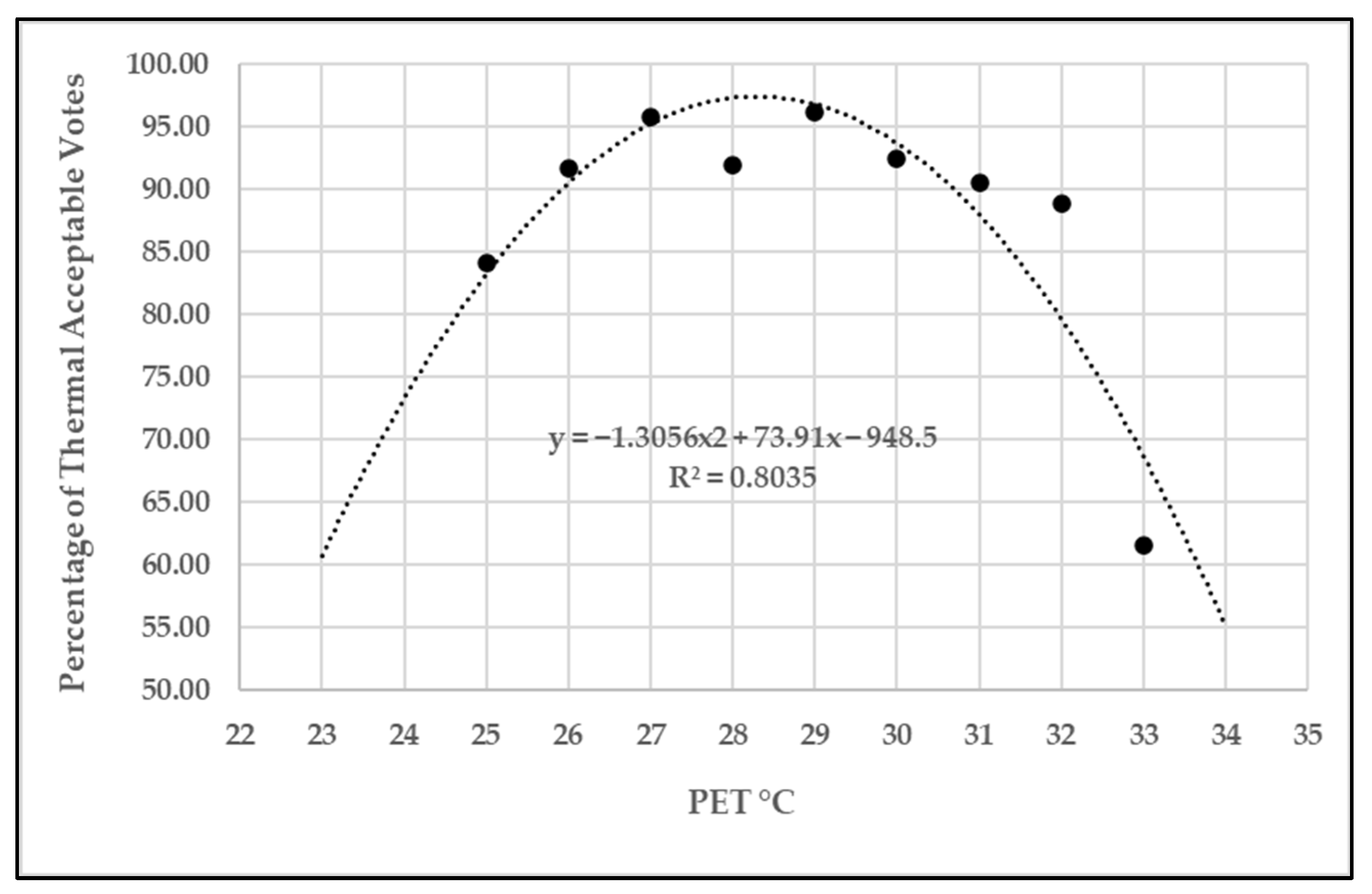
| Thermal Sensation | Physiological Stress | PET (°C) by Region | |
|---|---|---|---|
| (Sub) Tropical Region [24] | Temperate Region [30] | ||
| Very cold | Extreme cold stress | <14 | <4 |
| Cold | Strong cold stress | 14–18 | 4–8 |
| Cool | Moderate cold stress | 18–22 | 8–13 |
| Slightly cool | Slight cold stress | 22–26 | 13–18 |
| Neutral | No thermal stress | 26–30 | 18–23 |
| Slightly warm | Slight heat stress | 30–34 | 23–29 |
| Warm | Moderate heat stress | 34–38 | 29–35 |
| Hot | Strong heat stress | 38–42 | 35–41 |
| Very hot | Extreme heat stress | <42 | <41 |
| Factors | Walkway | ||||||
|---|---|---|---|---|---|---|---|
| All | No. 1 | No. 2 | No. 3 | No. 1 | No. 5 | ||
| Gender | Male | 170 | 35 | 42 | 42 | 37 | 14 |
| Female | 230 | 45 | 38 | 38 | 43 | 66 | |
| Age | Avg. | 21.6 | 22.6 | 24.6 | 21.6 | 20.2 | 18.9 |
| Max. | 47.0 | 42.0 | 47.0 | 41.0 | 30.0 | 28.0 | |
| Min. | 17.0 | 18.0 | 18.0 | 17.0 | 18.0 | 18.0 | |
| S.D. | 5.7 | 6.0 | 8.2 | 5.3 | 2.9 | 2.1 | |
| Weight (kg) | Avg. | 58.6 | 59.6 | 58.4 | 60.1 | 57.7 | 57.3 |
| Max. | 99.0 | 79.0 | 80.0 | 83.0 | 99.0 | 76.0 | |
| Min. | 42.0 | 49.0 | 45.0 | 50.0 | 42.0 | 45.0 | |
| S.D. | 8.6 | 7.5 | 8.4 | 7.4 | 11.3 | 7.6 | |
| Height (cm) | Avg. | 165.0 | 166.2 | 163.4 | 166.7 | 164.8 | 163.7 |
| Max. | 182.0 | 181.0 | 177.0 | 180.0 | 182.0 | 180.0 | |
| Min. | 148.0 | 148.0 | 149.0 | 149.0 | 150.0 | 150.0 | |
| S.D. | 7.0 | 7.0 | 6.8 | 7.3 | 7.4 | 6.2 | |
| Body Mass Index, BMI | Avg. | 21.5 | 21.6 | 21.8 | 21.6 | 21.2 | 21.3 |
| Max. | 34.3 | 28.7 | 27.7 | 27.7 | 34.3 | 27.1 | |
| Min. | 16.0 | 18.4 | 18.1 | 18.4 | 16.0 | 17.8 | |
| S.D. | 2.6 | 2.3 | 2.5 | 2.4 | 3.4 | 2.1 | |
| Clothing insulation, clo | Avg. | 0.55 | 0.52 | 0.57 | 0.55 | 0.56 | 0.54 |
| Max. | 0.67 | 0.61 | 0.67 | 0.67 | 0.67 | 0.57 | |
| Min. | 0.40 | 0.40 | 0.40 | 0.40 | 0.40 | 0.40 | |
| S.D. | 0.05 | 0.08 | 0.04 | 0.06 | 0.04 | 0.02 | |
| Parameters | Walkway | ||||||
|---|---|---|---|---|---|---|---|
| All | No. 1 | No. 2 | No. 3 | No. 4 | No. 5 | ||
| Tmrt (°C) | Avg. | 30.33 | 32.17 | 31.21 | 30.04 | 30.09 | 28.13 |
| Max. | 37.90 | 34.50 | 37.90 | 31.80 | 34.90 | 30.30 | |
| Min. | 25.70 | 28.70 | 26.90 | 28.40 | 27.40 | 25.70 | |
| S.D. | 2.41 | 1.73 | 2.89 | 1.04 | 2.31 | 1.53 | |
| Va (m/s) | Avg. | 0.57 | 0.66 | 0.51 | 0.52 | 0.55 | 0.60 |
| Max. | 2.30 | 1.90 | 1.80 | 1.30 | 2.30 | 1.40 | |
| Min. | 0.00 | 0.00 | 0.00 | 0.00 | 0.00 | 0.00 | |
| S.D. | 0.51 | 0.54 | 0.54 | 0.44 | 0.51 | 0.51 | |
| RH (%) | Avg. | 72.92 | 71.07 | 74.00 | 72.06 | 72.09 | 75.38 |
| Max. | 81.90 | 81.30 | 81.90 | 78.80 | 78.50 | 80.60 | |
| Min. | 64.60 | 66.40 | 66.00 | 65.30 | 64.60 | 69.70 | |
| S.D. | 4.55 | 4.36 | 4.78 | 4.22 | 4.28 | 3.86 | |
| Ta (°C) | Avg. | 28.69 | 29.84 | 28.73 | 28.66 | 28.45 | 27.77 |
| Max. | 31.90 | 31.30 | 31.90 | 30.30 | 31.40 | 29.70 | |
| Min. | 25.90 | 27.90 | 26.30 | 27.00 | 25.90 | 25.90 | |
| S.D. | 1.52 | 1.09 | 1.33 | 0.93 | 1.91 | 1.44 | |
| SVF | Avg. | 0.35 | 0.45 | 0.22 | 0.43 | 0.40 | 0.27 |
| Max. | 0.57 | 0.57 | 0.28 | 0.50 | 0.43 | 0.29 | |
| Min. | 0.16 | 0.38 | 0.16 | 0.35 | 0.36 | 0.24 | |
| S.D. | 0.11 | 0.07 | 0.06 | 0.08 | 0.04 | 0.02 | |
| PET (°C) | Avg. | 29.18 | 30.7 | 29.8 | 29.2 | 28.9 | 27.3 |
| Max. | 34.20 | 33.7 | 34.2 | 31.8 | 33.8 | 31.1 | |
| Min. | 23.40 | 27.0 | 25.5 | 26.5 | 24.2 | 23.4 | |
| S.D. | 2.48 | 2.0 | 2.4 | 1.5 | 2.7 | 2.5 | |
| PET (°C) | Thermal Sensation Votes (TSVs) | Total | MTSV | Thermal Acceptable Votes | ||||||
|---|---|---|---|---|---|---|---|---|---|---|
| 3 | 2 | 1 | 0 | −1 | −2 | −3 | ||||
| 23 | 0 | 0 | 0 | 0 | 3 | 3 | 0 | 6 | −1.50 | 6 (100.0%) |
| 24 | 0 | 0 | 7 | 6 | 5 | 0 | 0 | 18 | 0.10 | 18 (100.0%) |
| 25 | 0 | 3 | 8 | 14 | 6 | 0 | 0 | 31 | 0.26 | 26 (83.9%) |
| 26 | 0 | 2 | 6 | 7 | 5 | 0 | 0 | 20 | 0.25 | 18 (90.0%) |
| 27 | 0 | 5 | 14 | 11 | 8 | 0 | 0 | 38 | 0.42 | 36 (94.7%) |
| 28 | 6 | 18 | 38 | 13 | 5 | 0 | 0 | 80 | 1.10 | 74 (92.5%) |
| 29 | 2 | 6 | 19 | 5 | 9 | 0 | 0 | 41 | 0.69 | 39 (95.1%) |
| 30 | 5 | 27 | 19 | 8 | 3 | 2 | 0 | 64 | 1.28 | 59 (92.2%) |
| 31 | 8 | 22 | 14 | 6 | 0 | 0 | 0 | 50 | 1.63 | 45 (90.0%) |
| 32 | 6 | 14 | 4 | 3 | 2 | 0 | 0 | 29 | 1.67 | 26 (89.7%) |
| 33 | 8 | 6 | 4 | 2 | 0 | 0 | 0 | 20 | 2.00 | 12 (60.0%) |
| 34 | 0 | 0 | 3 | 0 | 0 | 0 | 0 | 3 | 1.00 | 3 (100.0%) |
| Total | 35 | 103 | 136 | 75 | 46 | 5 | 0 | 400 | 38 | 362 (90.5%) |
Disclaimer/Publisher’s Note: The statements, opinions and data contained in all publications are solely those of the individual author(s) and contributor(s) and not of MDPI and/or the editor(s). MDPI and/or the editor(s) disclaim responsibility for any injury to people or property resulting from any ideas, methods, instructions or products referred to in the content. |
© 2024 by the authors. Licensee MDPI, Basel, Switzerland. This article is an open access article distributed under the terms and conditions of the Creative Commons Attribution (CC BY) license (https://creativecommons.org/licenses/by/4.0/).
Share and Cite
Suwanmanee, N.; Kronprasert, N.; Sutheerakul, C.; Arunotayanun, K.; Rinchumphu, D. Investigation of Outdoor Thermal Comfort for Campus Pedestrian Walkways in Thailand. Sustainability 2024, 16, 657. https://doi.org/10.3390/su16020657
Suwanmanee N, Kronprasert N, Sutheerakul C, Arunotayanun K, Rinchumphu D. Investigation of Outdoor Thermal Comfort for Campus Pedestrian Walkways in Thailand. Sustainability. 2024; 16(2):657. https://doi.org/10.3390/su16020657
Chicago/Turabian StyleSuwanmanee, Naphat, Nopadon Kronprasert, Chomphunut Sutheerakul, Kriangkrai Arunotayanun, and Damrongsak Rinchumphu. 2024. "Investigation of Outdoor Thermal Comfort for Campus Pedestrian Walkways in Thailand" Sustainability 16, no. 2: 657. https://doi.org/10.3390/su16020657
APA StyleSuwanmanee, N., Kronprasert, N., Sutheerakul, C., Arunotayanun, K., & Rinchumphu, D. (2024). Investigation of Outdoor Thermal Comfort for Campus Pedestrian Walkways in Thailand. Sustainability, 16(2), 657. https://doi.org/10.3390/su16020657










